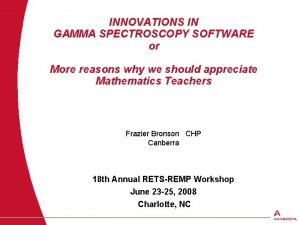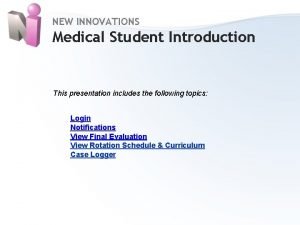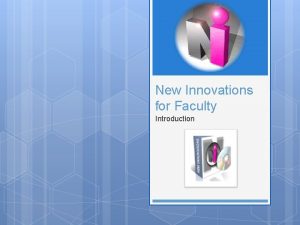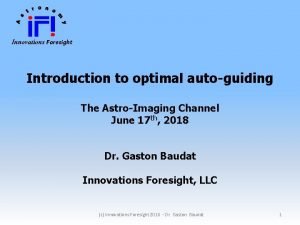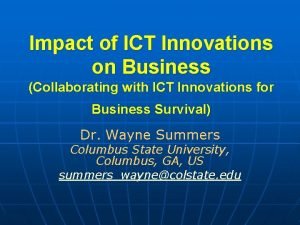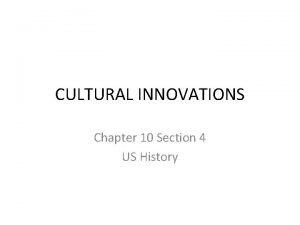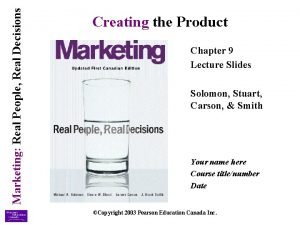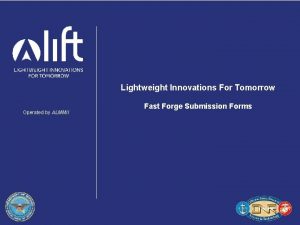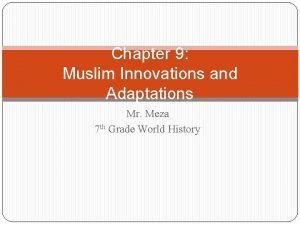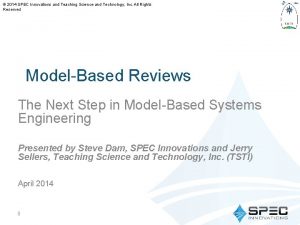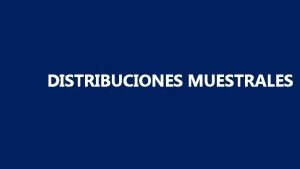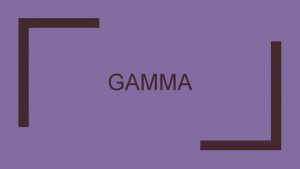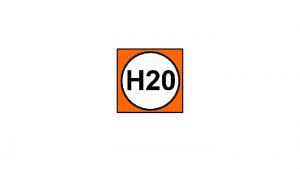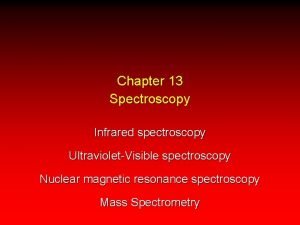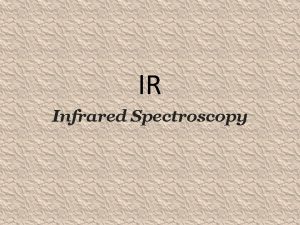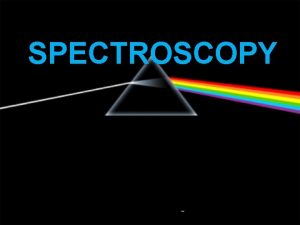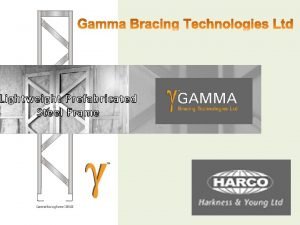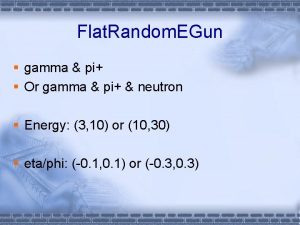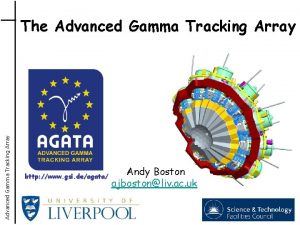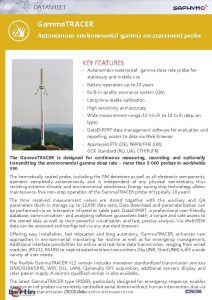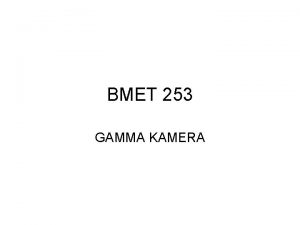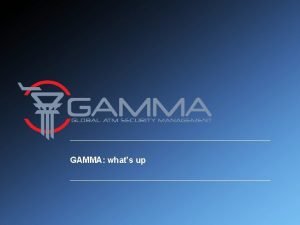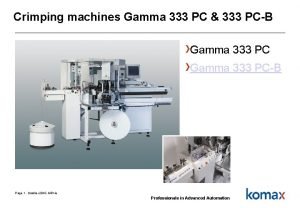INNOVATIONS IN GAMMA SPECTROSCOPY SOFTWARE or More reasons


![Stone Age Gamma Spectroscopy [when I started doing this] u Otto Frisch, 1951 w Stone Age Gamma Spectroscopy [when I started doing this] u Otto Frisch, 1951 w](https://slidetodoc.com/presentation_image_h/ccb0eacc52a482131325937b9a351160/image-3.jpg)











![Simplify your sample preparation with infinite geometry calibrations [1] u Conventional calibration w Units: Simplify your sample preparation with infinite geometry calibrations [1] u Conventional calibration w Units:](https://slidetodoc.com/presentation_image_h/ccb0eacc52a482131325937b9a351160/image-15.jpg)
![Simplify your sample preparation with infinite geometry calibrations [2] u Infinite calibration [thickness shown Simplify your sample preparation with infinite geometry calibrations [2] u Infinite calibration [thickness shown](https://slidetodoc.com/presentation_image_h/ccb0eacc52a482131325937b9a351160/image-16.jpg)









- Slides: 25

INNOVATIONS IN GAMMA SPECTROSCOPY SOFTWARE or More reasons why we should appreciate Mathematics Teachers Frazier Bronson CHP Canberra 18 th Annual RETS-REMP Workshop June 23 -25, 2008 Charlotte, NC

Agenda u A brief review of the first millennium of gamma spectroscopy in 5 minutes u Efficiency Calibrations u Cascade Summing Corrections u Future changes 2 2 2
![Stone Age Gamma Spectroscopy when I started doing this u Otto Frisch 1951 w Stone Age Gamma Spectroscopy [when I started doing this] u Otto Frisch, 1951 w](https://slidetodoc.com/presentation_image_h/ccb0eacc52a482131325937b9a351160/image-3.jpg)
Stone Age Gamma Spectroscopy [when I started doing this] u Otto Frisch, 1951 w 30 ch, 100 cps, 6 Hz u Tullamore – 1954 w 20 SCAs, x 5 switch = 100 ch u State of the art: w Human readout w Graph paper display w Adding machine net peak area w Radioactive efficiency standards w Graphical efficiency curve fitting 3 3 3

Middle Ages of Gamma Spectroscopy u Wilkinson ADC – ‘ 55, RIDL u Transistorized MCA – ’ 59 ND, TMC u TMC Blue Box 1 ft 3 MCA – ’ 61 u Teletype ASR 33 – ’ 63 u Central Computers – big, expensive, remote u State of the art: w Human peak search w Computer net peak area w Radioactive efficiency standards w Graphical efficiency curve fitting 4 4 4

Renaissance – life is getting easier u Ge(Li) detectors – ’ 64 Ortec, RCA, SSR, Nuclear Diodes u Portable Multi-Attitude Cryostat – ’ 68 Harshaw u HPGe detectors – ’ 73 PGT u Battery powered Field MCAs – ’ 81 ND u Computer as part of MCA – ’ 71 Tennecomp u State of the art: w DEC computers w Computer based peak analysis w Computer assisted graphical efficiency curve fitting w Radioactive efficiency standards in lab w HASL-258 infinite field efficiency calibration – ‘ 72 5 5 5

How we used to calibrate large things “in the olden days” when we had to walk 2 miles to school up-hill both ways The “Lego” calibration method - radioactive building blocks u Animal counters w Convertible sheep/cow/pig/snake phantom What’s wrong with u 32 detector WBC w Adjustable man – 70 to 400 lbs u Large “Box” counters this picture? Plenty u Soil conveyor assay system 6 6 6

Computers have changed everything they allow us to do mathematical modeling, efficiency calibrations, and data corrections u ’ 40 s - Fermi, von Neumann, et. al. started work at Los Alamos on Monte Carlo process for nuclear modeling u ’ 77 – MCNP released to general public u Canberra’s MCNP uses w ’ 80 s – used to model neutron assay systems w ’ 90 s – used to model gamma assay systems w ’ 94 – used to calibrate customer gamma systems [waste, In. Situ] w ’ 96 – used in production process for ISOCS software u Mathematical efficiency calibration software w Canberra: ‘ 97 – ISOCS for In. Situ; ’ 98 – Lab. SOCS for Laboratory geometries w Ortec: ’ 99 – Program Isotopic for boxes and drums u ’ 99 – Cascade summing corrections – Ortec, Canberra 7 7 7

Calibration methodologies Radioactive source calibrations Mathematical calibrations u Need appropriate licenses u Construct exact mathematical model of the item to be measured u Need radioactive sources w Sources with wide range of energies and proper activity w Without cascade summing u Need qualified and trained personnel u Construct exact duplicate of item to be measured w Size, shape, density, Z, w The most difficult part u Count the calibration source and construct the calibration curve u Interpolate to energy of interest u Compute the efficiency calibration at exact energies of interest u MCNP and others w Can be quite accurate as long as detector is well known l Helmer and Hardy – 0. 2% w Complicated and slow u ISOCS/Lab. SOCS w Generally good enough ~5% w Easy and fast w Accepted - About 1000 Ge detectors Characterized for ISOCS/Lab. SOCS use 8 8 8

Calibration process with ISOCS or Lab. SOCS u Select or create sample container u Enter characteristics of sample w height, density, material u Define any absorbers w e. g. sample shelf u Select detector from list u Enter source-detector distance u Compute energy/efficiency/error datapoints [5 -10 sec] u Compute efficiency curve u Use for sample analysis 9 9 9

ISOCS Calibrations 20 different sample shapes to choose from n n n n 10 Wide variety of sample shapes Multiple adjustable parameters for each sample shape Multiple sources & locations within each sample shape Sample sizes from points to VERY large Any location within 500 meter radius of detector Any energy from 45 - 7000 ke. V Collimators, both cylindrical and rectangular 10 10

Lab. SOCS Calibration Templates u box u cylinder from side u cylinder or cone from end u sphere u Marinelli beaker u complex shape [cylindrically symmetric] 11 11 11

If pre-defined materials not adequate, create your own with the Material Editor u Any material can be created by the user u All elements and all cross-sections are in library u Materials can be defined by chemical formula [H 2 O] or previous material [drydirt] to make combination [mud] 12 12 12

Mathematical Calibrations are better in many cases u Calibrate difficult matrices w Concrete, soil, gas, steel, oil, u Calibrate things at any density, don’t waste time adjusting sample to match calibration density w Vegetation, soil, u Calibrate at any Z Ratio of efficiency compared to efficiency at 0% Fe w Important at low E Fig 2 Efficiency error vs Fe soil content 1. 2 1. 1 1. 0 0. 9 0. 8 0. 7 60 ke. V 88 ke. V 122 ke. V 0. 6 0. 5 0. 4 0 13 5 10 Wt% of Fe in soil 15 13 13

Use Lab. SOCS to make your detector seem larger Used Lab. SOCS to determine optimum sample container shape for 500 cc sample for 3 different shapes of detectors l l Typical container used in laboratory l 7. 5 cm dia x 11. 3 cm deep Optimum 500 cc container l 12 cm dia x 4. 5 cm deep - Can gain ~30% higher efficiency with optimum container - Can then cut count time approx in half 14 14 14
![Simplify your sample preparation with infinite geometry calibrations 1 u Conventional calibration w Units Simplify your sample preparation with infinite geometry calibrations [1] u Conventional calibration w Units:](https://slidetodoc.com/presentation_image_h/ccb0eacc52a482131325937b9a351160/image-15.jpg)
Simplify your sample preparation with infinite geometry calibrations [1] u Conventional calibration w Units: counts/gamma = cps/gps w Calibration behavior Sample diameter Sample thickness Efficiency Sample density 15 15 15
![Simplify your sample preparation with infinite geometry calibrations 2 u Infinite calibration thickness shown Simplify your sample preparation with infinite geometry calibrations [2] u Infinite calibration [thickness shown](https://slidetodoc.com/presentation_image_h/ccb0eacc52a482131325937b9a351160/image-16.jpg)
Simplify your sample preparation with infinite geometry calibrations [2] u Infinite calibration [thickness shown here] w Units: cps/gram = efficiency * mass w Calibration behavior Sample diameter Sample thickness Efficiency Sample density u Fill container more than 10 cm u No volume or mass measurements u No density corrections u One efficiency calibration u Results in activity/gram u Saves time and labor 16 16 16

More tricks for Efficiency Calibrations Don’t do it !! u Traditional method: w Create calibration file for common geometries l Container type, shelf, volume, matrix, density w Prepare sample to match exact calibration geometries l Takes time and labor, curve fitting and interpolation errors u Today: w Fill container with any material, volume, density l Use all of sample; w Place it anywhere w Start count w Tell software the geometry l Container type, material, volume or mass, w Software finds peaks, computes efficiency at exact energy 17 l No curve fitting or interpolation l No calibration process to maintain, just QA to show nothing has changed 17 17

Summing Errors in Gamma Spectroscopy Random Summing w loss of peak area at very high count rate Cs-137 w independent of energy, sample-to-detector distance, number of nuclides in the sample w correctable with the use of a pulser or a stationary reference source g 1 True Coincidence Summing [Cascade Summing] w loss or gain of peak area as a function of nuclide decay scheme and geometry w independent of count rate - a problem for all samples Co-60 w different effect for different gamma energies of even the same nuclide w correctable by increasing the sample-to-detector distance, if you want to pay the lower MDA penalty w Many common nuclides have this problem l Co-60, Y-88, Ce-139, Eu-152, Cs-134, Ba-133 l Self-correcting if calibration and assay nuclide are SAME l l 18 g 1 g 2 For other nuclides with nearby energies, calibrations with these nuclides will be wrong [Cs-134, Zn-65, Fe-59, K-40, …] The higher the efficiency, the worse the problem 18 18

Magnitude of Cascade Summing Errors u Example is Eu-152 with 60% efficiency HPGe u 400 ml Marinelli beaker geometry [shown below] w from (-45%) for 244 ke. V to (+10%) for 1086 ke. V. u Point geometry: w from (-60%) for 244 ke. V to (+15%) for 1086 ke. V u For many other nuclides with many coincidence transitions the effect may be even larger. u Current Canberra and Ortec software can correct these errors 19 19 19

Genie 2000 Cascade Summing Correction Input needed Done once per detector P/T Calibration Done once per sample geometry Geometry Description From analysis Automatically done Cascade Summing Correction Corrected NID Results 12/1/2020 20

Geometry Description Works best with Lab. SOCS-Characterized detector and efficiency, but that isn‘t required Select sample shape Enter parameters describing sample Geometry Composer Creates file used in analysis Geometry Description (*. GEO) Internally, the calculations use the ISOCS/Lab. SOCS engines 12/1/2020 21 21 21

P/T (Peak to Total) Calibration automated feature of v 2. 0 241 Am 109 Cd 54 Mn Quick and easy to do Once per detector [not per geometry] Low cost uncalibrated button sources single gamma preferred no cascade gammas Just count at approx. 10 cm the software does the rest 137 Cs 113 Sn P/T calibration curve 12/1/2020 22 65 Zn 22 22

Current Cascade Summing Correction Results u Typical contact filter paper before and after CSC w Within 5% u Accuracy as a function of detector size w Works for all size detectors u Limitations: w Only for gamma-gamma coincidences w X-rays a problem on low energy detectors w Requires simple P/T calibration 23 23 23

What does the future hold ? ? ? u Improvements in ISOCS/Lab. SOCS w 3 -D graphical user interface for better visualization of the exact geometry modeled w 2 new templates for more complex modeling w 4 new complex collimators for waste assay applications w Updated mass attenuation data [2003 vs. 1982] w Lower energies – down to 15 ke. V w Uncertainty Estimator and Assay Planner w Lab. SOCS Complex Beaker Viewer and Editor w More features in Complex Beaker template u Cascade Summing improvements w Updated CSC nuclide library – now 205 nuclides and 2366 lines w Now include Xray-Gamma summing and Xray-511 summing w Total efficiency automatically calibrated – no sources need 24 24 24

25 25 25
 Lirik lagu more more more we praise you
Lirik lagu more more more we praise you More more more i want more more more more we praise you
More more more i want more more more more we praise you Ortec renaissance software
Ortec renaissance software The more you take the more you leave behind
The more you take the more you leave behind The more you study the more you learn
The more you study the more you learn Aspire not to
Aspire not to Newtons first law example
Newtons first law example Knowing more remembering more
Knowing more remembering more The more i give to thee the more i have
The more i give to thee the more i have More choices more chances
More choices more chances Human history becomes more and more a race
Human history becomes more and more a race Russian empire 1450 to 1750
Russian empire 1450 to 1750 Suny downstate new innovations
Suny downstate new innovations Lsuhsc new innovations
Lsuhsc new innovations Lucent technologies bell labs innovations
Lucent technologies bell labs innovations Innovation foresight
Innovation foresight Ict innovations for business
Ict innovations for business Lesson 4 cultural innovations
Lesson 4 cultural innovations Why was polo a popular sport among wealthy muslims?
Why was polo a popular sport among wealthy muslims? New innovations duty hours
New innovations duty hours Next level innovations
Next level innovations Marketing real people real decisions
Marketing real people real decisions Lightweight innovations for tomorrow
Lightweight innovations for tomorrow Muslim innovations and adaptations
Muslim innovations and adaptations Innovations in modern banking
Innovations in modern banking Spec innovations
Spec innovations


